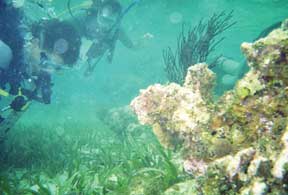|
News Notes
Oceanography
Corals adapt to sea change
 Reef-building corals are notoriously picky about their environment, only thriving if the conditions are right — but, in a pinch, it seems, they will try to make do. When seawater chemistry changes, some corals can change their structural makeup in an effort to adjust — making them the first creatures known to do so, according to a new study.
Reef-building corals are notoriously picky about their environment, only thriving if the conditions are right — but, in a pinch, it seems, they will try to make do. When seawater chemistry changes, some corals can change their structural makeup in an effort to adjust — making them the first creatures known to do so, according to a new study.
Geochemist Justin Ries and a student assess the health of corals growing near Roatan, Honduras. A new study shows that some corals can adapt to chemical changes in the ocean by changing their structural composition. Photograph is by Amy Vastine Ries.
Calcium carbonate, which comprises limestone, seashells and corals, comes in two primary versions that share the same chemical formula, but have different crystal structures: aragonite, which forms long, needle-like crystals, and calcite, which forms blocky, rhombus-shaped crystals. Currently, the oceans contain more than five times more magnesium than calcium — conditions that favor the formation of aragonite.
Modern reef-building corals currently construct their skeletons exclusively from aragonite, says Justin Ries, a marine biogeochemist at Johns Hopkins University in Baltimore, Md. These “scleractinian” corals have been constructing massive reefs for hundreds of millions of years, but “there’s an anomaly in the fossil record,” Ries says. Although they flourished from about 245 million to 140 million years ago, he says, scleractinian coral reefs became scarce beginning in the mid- to late Cretaceous (about 100 million years ago). Then, by 35 million years ago, they had once again become the major reef-builders in the ocean.
One possible explanation for this anomaly is that the corals’ growth is linked to changes in seawater chemistry, particularly the ratio of dissolved magnesium to calcium. Past work has suggested that the ratio changes over time as a result of varying rates of magma upwelling at mid-ocean ridges. And now, Ries says, the fluctuation in scleractinian corals’ reef-building activity appears to indeed correspond to changes in the oceans’ magnesium-to-calcium ratio.
To determine how coral growth responds to seawater chemistry, Ries, along with Lawrence Hardie, a geochemist also at Johns Hopkins University and Steven Stanley, a paleobiologist at the University of Hawaii in Honolulu, grew each of three species of scleractinian coral in five tanks filled with artificial seawater. The seawater in each tank was identical aside from its magnesium to calcium ratio, which ranged from 1 — the ratio during the mid-Cretaceous — to 5.2, the modern seawater ratio.
The team allowed the corals to grow for 60 days in the altered seawater. They then observed that the rate of growth of all three species had slowed considerably in the lower-magnesium seawater tanks, particularly when the magnesium-to-calcium ratio dropped below 2 — similar to the chemistry in the oceans during the mid- to late Cretaceous, Ries says.
The results suggest that unfavorable ocean chemistry may have limited these corals from building massive reefs, Ries says. Even more surprisingly, however, the team found that, upon analyzing the corals’ skeletal structure, the previously aragonitic corals had begun to build as much as a third of their skeletons out of calcite, the researchers reported in the July issue of Geology.
This case is the first known of an organism “changing the [crystal] composition of its skeleton based on environmental parameters,” Ries says — though the change comes at a cost to the corals. Other modern sea creatures that prefer to build their shells from calcite rather than aragonite have found less drastic ways to cope with the extra magnesium in the modern ocean, he says. Urchins, crabs and shrimp, for example, are able to fit the extra magnesium into their skeletons without changing their mineralogy or significantly altering their rates of growth. Other species, such as mollusks, exert strong control over their internal chemical environment and are apparently unaffected by the seawater’s changeability, continuing to produce predominately low-magnesium calcite shells.
Ries’ team’s study is “a fascinating piece of work,” says Peter Swart, a geologist at the University of Miami Rosenstiel School of Marine and Atmospheric Science in Florida. In future studies, Swart says, adding a red stain to the corals during their growth, to more clearly mark the change between old and new growth in images of their skeletons, would further strengthen the argument that the change in crystal structure is biological rather than inorganic.
In the meanwhile, the current study is “convincing,” Swart says. “It shows that these organisms really are at the mercy of the chemistry of the oceans.”
Carolyn Gramling

 Subscribe
Subscribe

